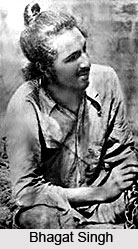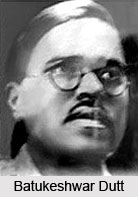 A great patriot herself, Durga Devi (wife of Bhagwati Charan Vohra) posed as Bhagat Singh`s wife, put her son Sachinder in his lap and accompanied him to the Lahore railway station. As per the judgement, on 20th December 1928, Bhagat Singh travelled second class and Shiv Ram Rajguru travelled as his servant. They boarded the train and Bhagat Singh successfully sneaked out of Lahore and reached Calcutta. Panditji (Chandrashekhar Azad) accompanied by Kishori Lai left Lahore on 25th December 1928 for Delhi where Kishori Lai left him and retuned to Lahore. A criminal case namely Lahore Conspiracy Case was registered, and the police sprung into action by conducting raids and searches and making arrests. But Bhagat Singh, with other revolutionary patriots, was planning a still bigger deed.
A great patriot herself, Durga Devi (wife of Bhagwati Charan Vohra) posed as Bhagat Singh`s wife, put her son Sachinder in his lap and accompanied him to the Lahore railway station. As per the judgement, on 20th December 1928, Bhagat Singh travelled second class and Shiv Ram Rajguru travelled as his servant. They boarded the train and Bhagat Singh successfully sneaked out of Lahore and reached Calcutta. Panditji (Chandrashekhar Azad) accompanied by Kishori Lai left Lahore on 25th December 1928 for Delhi where Kishori Lai left him and retuned to Lahore. A criminal case namely Lahore Conspiracy Case was registered, and the police sprung into action by conducting raids and searches and making arrests. But Bhagat Singh, with other revolutionary patriots, was planning a still bigger deed.
On 8th April 1929, at about 12.30 p.m., when Sir George Chestar stood up in the Central Assembly, New Delhi to make an announcement regarding the exercise of special power by the viceroy for passing the Public Safety Bill, Bhagat Singh and Batukeshwar Dutt who were occupying seats in the visitors` gallery, stood up and threw two bombs, one after the other, near Sir Chester, not with an intention to kill him but to awaken the British government to the reach of revolutionaries. There was complete chaos in the assembly. Bhagat Singh and Batukeshwar Dutt raised slogans `Inquilab Zindabad` (Long live revolution) and `Samrajya ka nash ho` (Down with imperialism). They also threw pamphlets in the assembly and surrendered willingly. A challan was presented against them under Section 307 Indian Penal Code and Section 3 of Explosives Act in the court of ADM Delhi on 7th May 1929. They were committed to the court of the sessions judge, Delhi. Bhagat Singh read out his detailed statement in the court on 6th June 1929. Asaf Ali was the defence counsel. The judgement was announced on 12th June 1929 and both were sentenced to life imprisonment. Immediately thereafter, they were shifted to the Punjab jail to face the trial in Lahore Conspiracy Case. The judgement was upheld by the High Court on 13th January 1930 which is reported as Bhagat Singh and Another versus Emperor AIR 1930 Lahore 266.
The trial of Lahore Conspiracy Case started in Central Jail, Lahore on 10th July 1929, when the challan was presented in the court of the special magistrate against thirty-two persons out of whom nine, including Chandra Shekhar Azad were declared absconders, seven had turned approvers and sixteen of them were facing trial. However, the trial could not proceed further as those under trials who had resorted to a hunger strike against the poor quality of food and inhuman conditions in the jail, could not be produced in the court. Jatindranath Dass, an under trial in this case attained martyrdom on 13th September 1929 at 1.10 p.m., after his hunger strike for sixty-four days. Thereafter, the procedure of trial was changed by issuing an ordinance on 1st May 1930.
 A Special Tribunal was constituted and the right of appeal was eliminated. The trial before the tribunal started on 10th July 1930. The political prisoners enkindled patriotic slogans in the court. "Mera rang de basanti chola, Ma, mera rang de basanti chola" was their favourite song which had an enamouring impact on the youth. The judgement for the Lahore Conspiracy Case was delivered on 7th October 1930. Bhagat Singh, Rajguru and Sukhdev were sentenced to death. Kishori Lai Rattan, Sheo (Shiv) Verma, Dr. Gaya Prasad, Jai Dev Kapur, Bejoy Kumar Sinha, Mahabir Singh and Kamal Nath Tiwari were sentenced to life imprisonment; Kundal Lai Gupta was sentenced to seven years, while Prem Dutt received five years. Three others were acquitted. Out of the absconders, Chander Shekhar Azad attained martyrdom in an encounter with the police in Azad Park, Allahabad in February 1931, while Bhagwati Charan had died in a bomb explosion in May 1930, when he was rehearsing the bomb attack planned for the escape of Bhagat Singh. Bhagat Singh, Raj Guru and Sukhdev were taken to the gallows at 7.00 p.m. on 23rd March 1931. Cheerfully they proceeded raising the slogans "Inquilab Zindabad" "Down down Union Jack" "Down with British Imperialism".
A Special Tribunal was constituted and the right of appeal was eliminated. The trial before the tribunal started on 10th July 1930. The political prisoners enkindled patriotic slogans in the court. "Mera rang de basanti chola, Ma, mera rang de basanti chola" was their favourite song which had an enamouring impact on the youth. The judgement for the Lahore Conspiracy Case was delivered on 7th October 1930. Bhagat Singh, Rajguru and Sukhdev were sentenced to death. Kishori Lai Rattan, Sheo (Shiv) Verma, Dr. Gaya Prasad, Jai Dev Kapur, Bejoy Kumar Sinha, Mahabir Singh and Kamal Nath Tiwari were sentenced to life imprisonment; Kundal Lai Gupta was sentenced to seven years, while Prem Dutt received five years. Three others were acquitted. Out of the absconders, Chander Shekhar Azad attained martyrdom in an encounter with the police in Azad Park, Allahabad in February 1931, while Bhagwati Charan had died in a bomb explosion in May 1930, when he was rehearsing the bomb attack planned for the escape of Bhagat Singh. Bhagat Singh, Raj Guru and Sukhdev were taken to the gallows at 7.00 p.m. on 23rd March 1931. Cheerfully they proceeded raising the slogans "Inquilab Zindabad" "Down down Union Jack" "Down with British Imperialism".
The following people convicted along with Shaheed Bhagat Singh in the Lahore Conspiracy Case were deported to the Cellular Jail:
• Gya Parshad , Dr. B.S Nigham , Ram Lai , Ram Nath , Desh Bhagat - aged 26 years s/o Mauji Ram r/o of Khajuri Khurd, Billhaur, Distt. Cawnpore (U.P.)
• Jai Dev (Kanpur) , Harish Chander - aged 23 years s/o Babu Salig Ram, Khaatri Kapur r/o Saddar Bazaar, Hardoi (U.R)
• Kundan Lai , Partap (Gupta) No.l - aged 27 years r/o Fyzabad (U.R).
• Mahabir Singh, Partab (D.O.B. 16.09.1908) s/o Kunwar Devi Singh r/o Shahpore Tehla, Post Office Raja ke Rampur, Distt. Eta (U.R).
• Bijoy Kumar Sinha, Bachu - aged 23 years s/o Markando Kumar Sinha r/o Mohalla Karachi Ganj, Cawnpore.
• Kanwal Nath Trivedi , Kanwal Nath Tewari - aged 23 years s/o Pandit Surej Nath Tewari r/o Sarya, Police Station Govindagunj, Champaran, Bihar.
• Sheo Varma , Parbhat , Harnarain , Ram Narain Kapur - aged 23 years s/o Kanhiya Lai Varma, Khatri r/o Hardoi (U.R).



















